Inscriptions, texts nos. 87-99
Browse the RIA 5 Corpus [/riao/ria5/pager/]
87 88 89 90 91 92 93 94 95 96 97 98 99
87 - Black Obelisk's Epigraphs
This is the first of five epigraphs (nos. 87-91) engraved on the Black Obelisk (the main text of which has been edited as no. 14). Each epigraph appears above scenes carved in relief depicting the tribute being paid. This epigraph records receipt of tribute from Gilzanu, an event mentioned in the annals for the accession year (859 BC). Here, the name of the king of Gilzanu, Sūa, is a different spelling for the ruler who is called Asû in the annals (see no. 6 i 41).
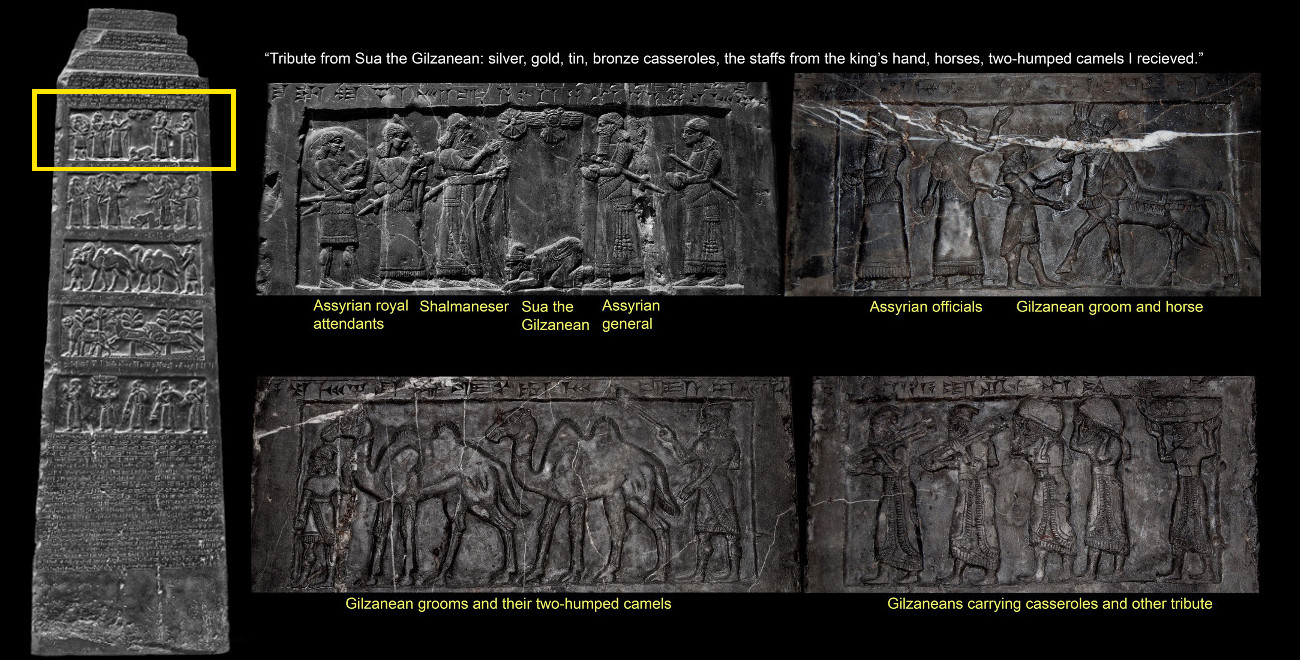
BM 118885. Elaboration from Nimrud: Materialities of Assyrian Knowledge Production [/nimrud/livesofobjects/blackobelisk/index.html] © The Trustees of the British Museum.
Access the composite text [/riao/ria5/Q004692/] of Shalmaneser III 87.
Bibliography
88 - Black Obelisk's Epigraphs
This epigraph on the Black Obelisk (see no. 87) records the receipt of tribute from Jehu, king of Israel ("house of Omri"), in the eighteenth year (841 BC), as described in the annals: see no. 8 [/riao/ria5/Q004613/] lines 26''-27'', no. 10 [/riao/ria5/Q004615/] iv 10-12, and no. 12 [/riao/ria5/Q004617/] lines 29-30.
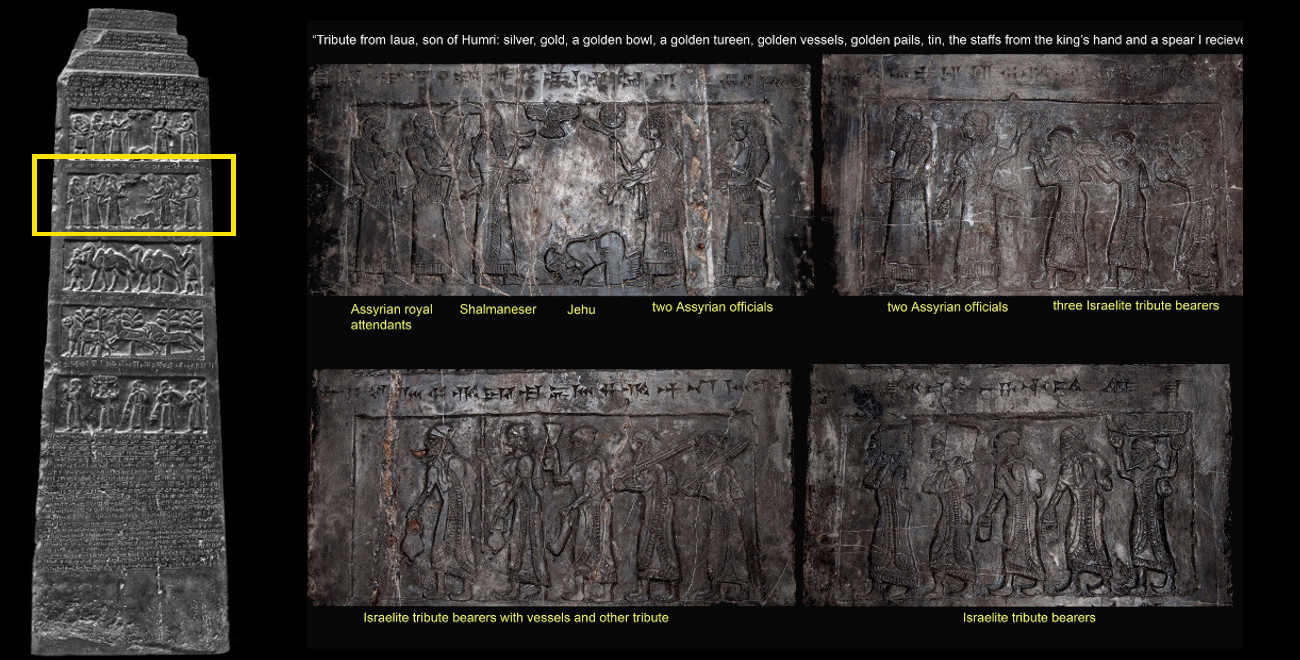
BM 118885. Elaboration from Nimrud: Materialities of Assyrian Knowledge Production [/nimrud/livesofobjects/blackobelisk/index.html] © The Trustees of the British Museum.
Access the composite text [/riao/ria5/Q004693/] of Shalmaneser III 88.
Bibliography
89 - Black Obelisk's Epigraphs
This epigraph on the Black Obelisk (see no. 87) records the receipt of the tribute from Egypt. The date of this event is unknown since the only reference to Egypt in the annals is about its participation in the Battle of Qarqar in 853 BC (see no. 2 [/riao/ria5/Q004607/] ii 92), and the receipt of this exotic tribute would hardly fit in those circumstances. The tribute includes some interesting animals, portrayed in relief, and the last two pairs look respectively like monkeys and apes. Grayson has corrected the reading of the text (gi* is actually ZI and pu* is actually MI) and assumed that bagiāti = pagiāti. Deller, in the other hand, read ú-qup GE6.MEŠ "black apes."
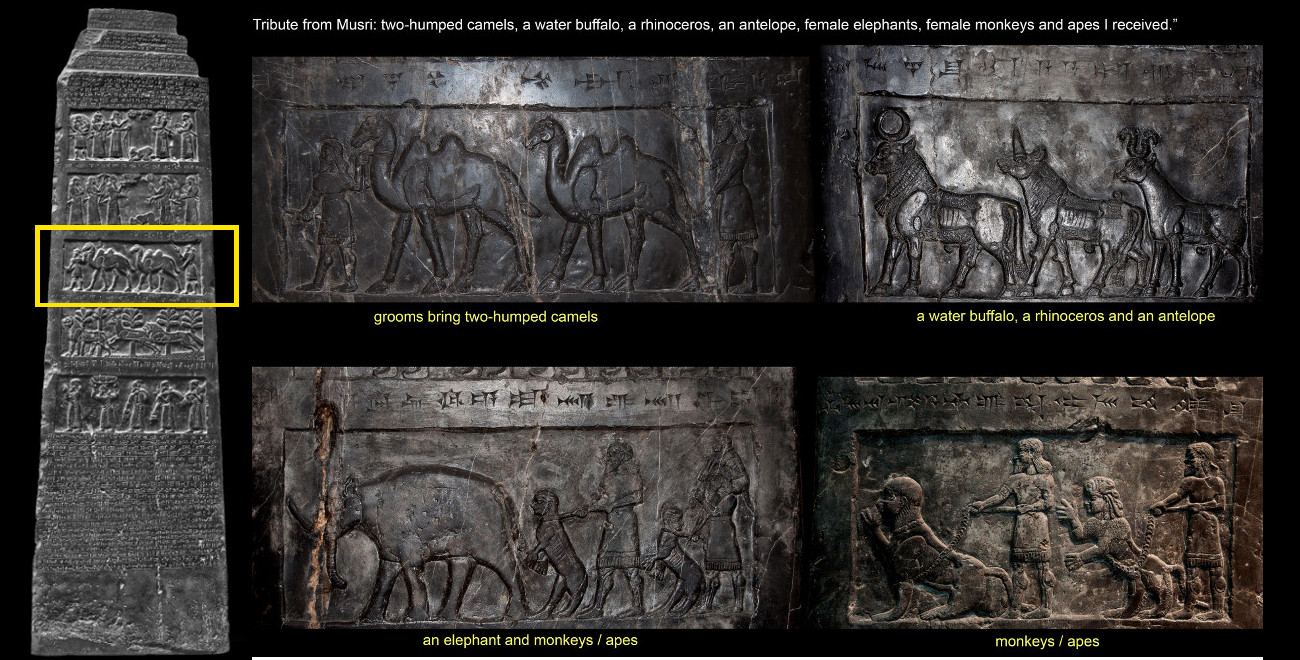
BM 118885. Elaboration from Nimrud: Materialities of Assyrian Knowledge Production [/nimrud/livesofobjects/blackobelisk/index.html] © The Trustees of the British Museum.
Access the composite text [/riao/ria5/Q004694/] of Shalmaneser III 89.
Bibliography
90 - Black Obelisk's Epigraphs
This epigraph on the Black Obelisk (see no. 87) concerns the receipt of the tribute from Marduk-apla-uṣur, a ruler of Suḫi. The event is otherwise unrecorded in any known text of Shalmaneser III. The scribe has mistakenly written bu-ú-IA for bu-ú-ṣi.
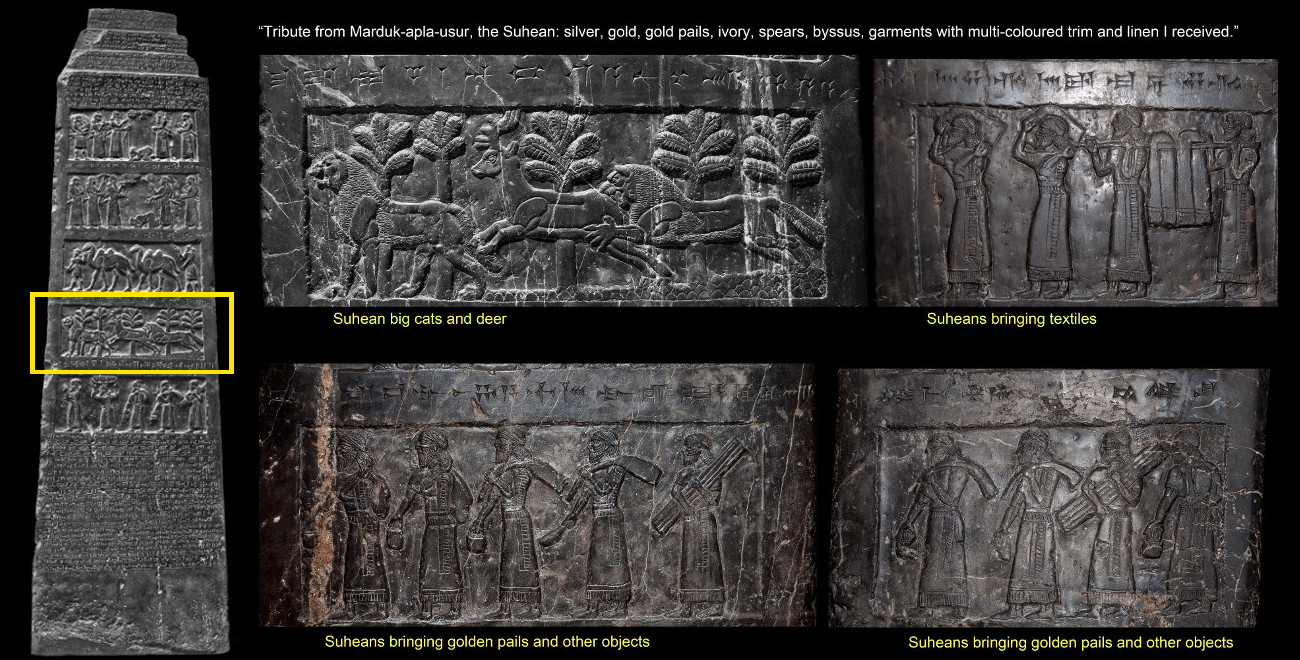
BM 118885. Elaboration from Nimrud: Materialities of Assyrian Knowledge Production [/nimrud/livesofobjects/blackobelisk/index.html] © The Trustees of the British Museum.
Access the composite text [/riao/ria5/Q004695/] of Shalmaneser III 90.
Bibliography
91 - Black Obelisk's Epigraphs
This epigraph on the Black Obelisk (see no. 87) concerns receipt of the tribute from Qarparunda of the land Patinu. In the annals, the receipt of Qarparunda's tribute is recorded for three different years: second (857 BC) see no. 2 [/riao/ria5/Q004607/] ii 21-24; seventh (853 BC) see no. 2 [/riao/ria5/Q004607/] ii 82-86; eleventh (848 BC) see no. 8 [/riao/ria5/Q004613/].
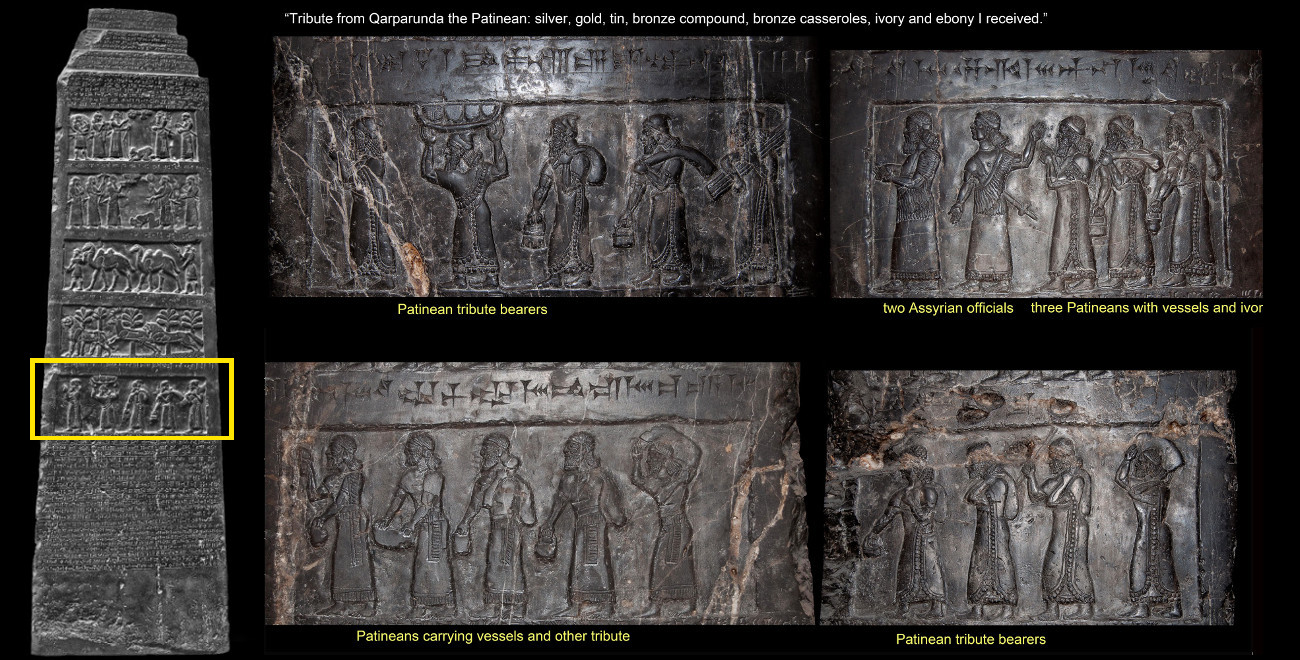
BM 118885. Elaboration from Nimrud: Materialities of Assyrian Knowledge Production [/nimrud/livesofobjects/blackobelisk/index.html] © The Trustees of the British Museum.
Access the composite text [/riao/ria5/Q004696/] of Shalmaneser III 91.
Bibliography
92
A small cylinder (4.1 cm long and 1.5 in diameter) made of black stone with white veins and bored through the centre, was discovered at Ashur and has an inscription that identifes it as part of the booty from the city of Malaḫa, which was part of the territory under the control of Hazael of Damascus. The object could not be located or collated by Grayson.
Access the composite text [/riao/ria5/Q004697/] of Shalmaneser III 92.
Bibliography
93
Two stone door sockets belonging to a dorway of the Anu-Adad temple at Ashur, bear two exact copies of the same text. The objects could not be located or collated by Grayson.
Access the composite text [/riao/ria5/Q004698/] of Shalmaneser III 93.
Bibliography
94
A stone mace head measuring 11 cm in diameter and 8 cm in high was found with a number of other mace heads at the Tabira Gate in Ashur. The head is engraved with an inscription that certrificates that the mace was deliberately deposited by the Gate. Furhtermore, it tells us that the weapon was part of the booty from Marduk-mudammiq, king of Namri, against whom Shalmaneser led a campaign in his sixteenth regnal year (843 BC).
Access the composite text [/riao/ria5/Q004699/] of Shalmaneser III 94.
Bibliography
95
A stone altar found in the plain of Nineveh (a more precise
provenance is not given) measures 68 cm high, 103 cm long and 74 cm
wide. It was engraved with a dedicatory inscription to the gods
Sibitti with a number of their epithets.
A notable features of this object is the presence of two Greek
inscriptions added later, which name an official (Apollonios) and the
dedication of the altar to the city.
Access the composite text [/riao/ria5/Q004700/] of Shalmaneser III 95.
Bibliography
96
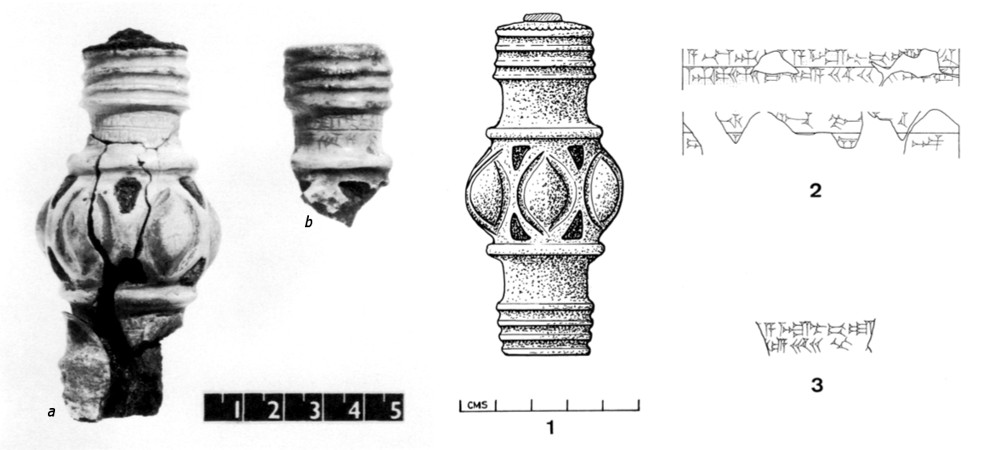
Elaboration from: Curtis and Grayson, Iraq 44 p. 94 and pl. III: a) BM 131128; b) 1855-12-05, 0025; 1) Reconstructed drawing of BM 131128 by Ann Searight; 2) BM 131128; 3) 1855-12-05, 0025.
Two stone mace heads from Tarbiṣu bear similar inscriptions. Missing portions of the text have been restored from text no. 97.
Access the composite text [/riao/ria5/Q004701/] of Shalmaneser III 96.
Bibliography
97
A stone mace head of unknown provenance bears a dedicatory inscription of Shalmaneser to the god Amurru.
Access the composite text [/riao/ria5/Q004702/] of Shalmaneser III 97.
Bibliography
98
This text number was deleted in Grayson, RIMA 3 (p. 155).
99
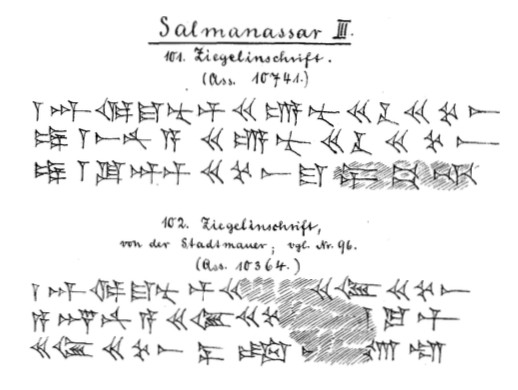
KAH 2 nos. 101-102
This text, recording works on the wall of Ashur's Inner City, is inscribed on a number of bricks from Ashur.
Access the composite text [/riao/ria5/Q004704/] of Shalmaneser III 99.
Bibliography
Nathan Morello
Nathan Morello, 'Inscriptions, texts nos. 87-99', RIA 5: Inscriptions of Shalmaneser III and His Successors (858–745 BC), The RIA Project, 2025 [http://oracc.org/ShalmaneserIII/Texts87-99/]